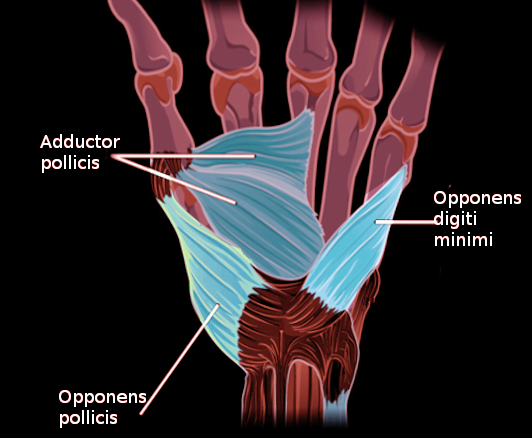[1]
Adams JE, O'Brien V, Magnusson E, Rosenstein B, Nuckley DJ. Radiographic Analysis of Simulated First Dorsal Interosseous and Opponens Pollicis Loading Upon Thumb CMC Joint Subluxation: A Cadaver Study. Hand (New York, N.Y.). 2018 Jan:13(1):40-44. doi: 10.1177/1558944717691132. Epub 2017 Feb 16
[PubMed PMID: 28719976]
[2]
McDannald DW, Mansour M, Rydalch G, Bolton DAE. Motor affordance for grasping a safety handle. Neuroscience letters. 2018 Sep 14:683():131-137. doi: 10.1016/j.neulet.2018.05.040. Epub 2018 May 29
[PubMed PMID: 29857040]
Level 3 (low-level) evidence
[3]
Senthinathan B, Sousa C, Tannahill D, Keynes R. The generation of vertebral segmental patterning in the chick embryo. Journal of anatomy. 2012 Jun:220(6):591-602. doi: 10.1111/j.1469-7580.2012.01497.x. Epub 2012 Mar 28
[PubMed PMID: 22458512]
[4]
Sagarin KA, Redgrave AC, Mosimann C, Burke AC, Devoto SH. Anterior trunk muscle shows mix of axial and appendicular developmental patterns. Developmental dynamics : an official publication of the American Association of Anatomists. 2019 Oct:248(10):961-968. doi: 10.1002/dvdy.95. Epub 2019 Aug 16
[PubMed PMID: 31386244]
[5]
Bigler MR, Buffle E, Siontis GCM, Stoller M, Grossenbacher R, Tschannen C, Seiler C. Invasive Assessment of the Human Arterial Palmar Arch and Forearm Collateral Function During Transradial Access. Circulation. Cardiovascular interventions. 2019 Jul:12(7):e007744. doi: 10.1161/CIRCINTERVENTIONS.118.007744. Epub 2019 Jul 5
[PubMed PMID: 31272228]
[6]
Katz R, Mazzocchio R, Pénicaud A, Rossi A. Distribution of recurrent inhibition in the human upper limb. Acta physiologica Scandinavica. 1993 Oct:149(2):183-98
[PubMed PMID: 8266808]
[7]
Gupta S, Michelsen-Jost H. Anatomy and function of the thenar muscles. Hand clinics. 2012 Feb:28(1):1-7. doi: 10.1016/j.hcl.2011.09.006. Epub
[PubMed PMID: 22117918]
[8]
Homma T, Sakai T. [Anatomy of intrinsic hand muscles]. Kaibogaku zasshi. Journal of anatomy. 1994 Apr:69(2):123-42
[PubMed PMID: 8023676]
[9]
Homma T, Sakai T. Thenar and hypothenar muscles and their innervation by the ulnar and median nerves in the human hand. Acta anatomica. 1992:145(1):44-9
[PubMed PMID: 1414212]
[10]
Bertelli JA, Soldado F, Rodrígues-Baeza A, Ghizoni MF. Transferring the Motor Branch of the Opponens Pollicis to the Terminal Division of the Deep Branch of the Ulnar Nerve for Pinch Reconstruction. The Journal of hand surgery. 2019 Jan:44(1):9-17. doi: 10.1016/j.jhsa.2018.09.010. Epub 2018 Oct 23
[PubMed PMID: 30366737]
[11]
Dyro FM. Ulnar innervation of opponens pollicis. Electromyography and clinical neurophysiology. 1983 May-Jun:23(4):257-60
[PubMed PMID: 6872925]
[12]
Neth MR. Acute hand pain resulting in spontaneous thenar compartment syndrome. The American journal of emergency medicine. 2019 Mar:37(3):561.e3-561.e4. doi: 10.1016/j.ajem.2018.11.035. Epub 2018 Nov 24
[PubMed PMID: 30527915]
[13]
Jupiter JB, Nunez FA Jr, Nunez F Sr, Fernandez DL, Shin AY. Current Perspectives on Complex Wrist Fracture-Dislocations. Instructional course lectures. 2018 Feb 15:67():155-174
[PubMed PMID: 31411409]
Level 3 (low-level) evidence
[14]
Lin CP, Chen IJ, Chang KV, Wu WT, Özçakar L. Utility of Ultrasound Elastography in Evaluation of Carpal Tunnel Syndrome: A Systematic Review and Meta-analysis. Ultrasound in medicine & biology. 2019 Nov:45(11):2855-2865. doi: 10.1016/j.ultrasmedbio.2019.07.409. Epub 2019 Aug 9
[PubMed PMID: 31402226]
Level 1 (high-level) evidence

